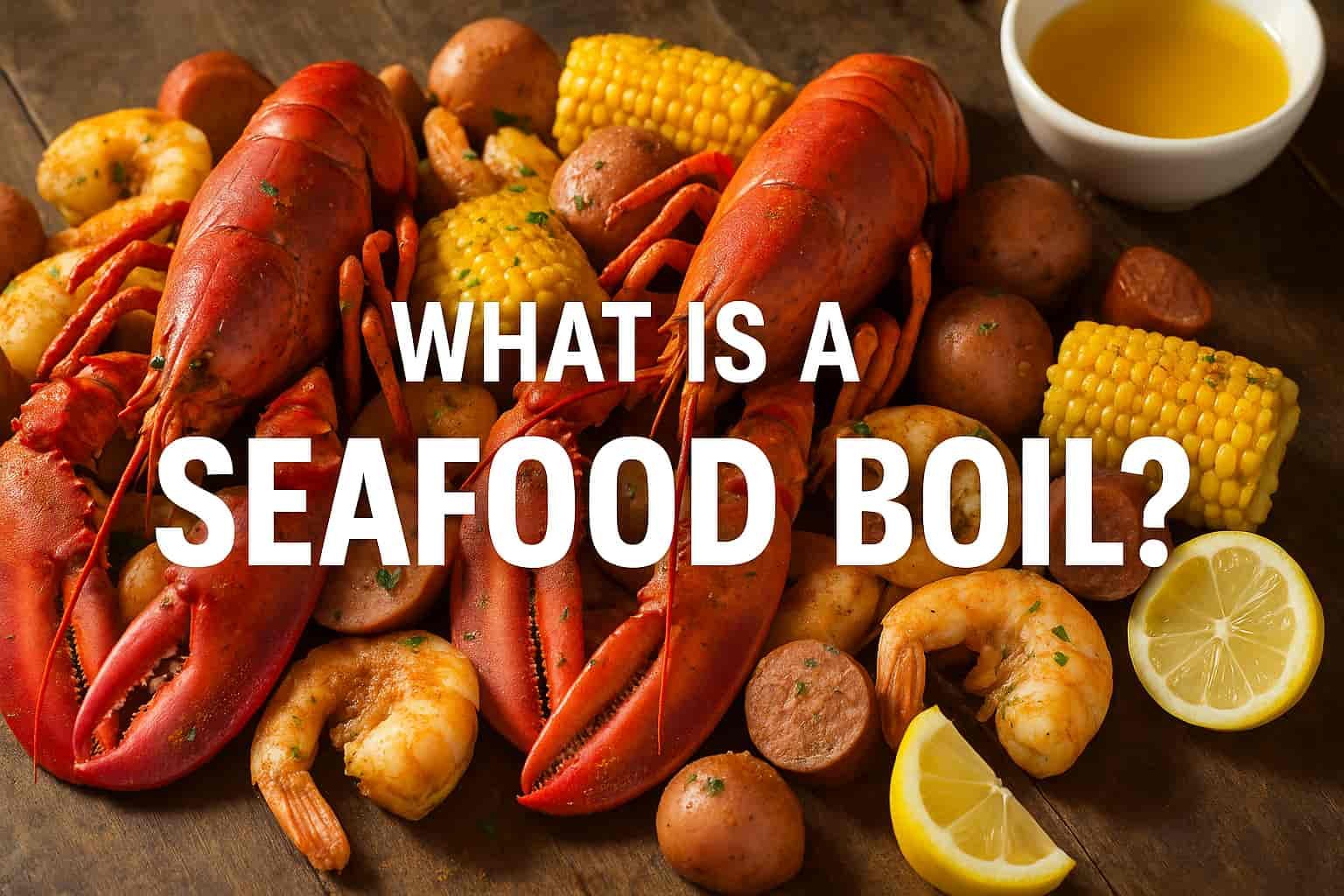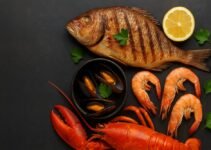A seafood boil is more than just a meal; it is a cultural dining event rooted in coastal traditions and communal gatherings. Known for its abundance of fresh seafood and bold, flavorful seasonings, a seafood boil brings people together around a shared table, often lined with newspaper or butcher paper, where food is poured out and enjoyed by hand. This experience originated in the coastal regions of the United States, particularly in the South, where seafood is abundant and social dining is a way of life.
In this guide, you will discover exactly what a seafood boil is, why it remains popular today, and how different regions have developed their own distinctive styles. From the types of seafood used to the essential side ingredients and seasoning blends, every detail is covered to help you understand and recreate this flavorful tradition at home. Whether you are planning your first seafood boil or looking to refine your recipe, this article will provide clear, actionable insights backed by culinary traditions and nutritional considerations.
Contents
- 1 What Is a Seafood Boil and Why Is It So Popular?
- 2 What Types of Seafood Are Commonly Used in a Seafood Boil?
- 3 What Ingredients Besides Seafood Are Essential for a Flavorful Boil?
- 4 How Do You Properly Prepare and Cook a Seafood Boil at Home?
- 5 What Are the Most Popular Seafood Boil Seasoning Blends and Sauces?
- 6 What Nutritional Value Does a Seafood Boil Offer?
- 7 How Do You Host a Successful Seafood Boil Party?
- 8 What Are the Best Beverages to Pair with a Seafood Boil?
- 9 How Should Leftover Seafood Boil Be Stored and Reheated Safely?
What Is a Seafood Boil and Why Is It So Popular?
A seafood boil is a large-batch cooking method that combines various seafood types with vegetables and bold seasonings, served directly from the pot for communal eating. It is popular because it transforms a simple meal into a vibrant social event, encouraging shared experiences and cultural connection.
The popularity of seafood boils stems from three main factors:
- Social Experience: It fosters interaction and conversation as guests gather around the table to enjoy the meal together.
- Flavor Complexity: The cooking process infuses seafood and vegetables with rich, spicy flavors that appeal to a wide range of palates.
- Accessibility of Ingredients: Coastal regions provide fresh seafood, making this style of cooking both practical and affordable in those areas.
How Did the Seafood Boil Tradition Originate in the United States?
The seafood boil tradition originated from French, Spanish, and African culinary influences in the Southern United States during the 18th century. Communities in Louisiana, South Carolina, and Georgia adapted European cooking methods to local seafood abundance, creating what is now known as the Cajun and Lowcountry seafood boils.
Key historical influences include:
- Cajun Culture: Known for bold, spicy flavors using local crawfish, shrimp, and crab.
- Gullah-Geechee Heritage: Focused on communal cooking and using local blue crabs and oysters.
- Spanish Paella Influence: Inspired one-pot cooking with a mix of proteins and vegetables.
Which Coastal Regions Are Famous for Their Seafood Boil Styles?
There are four primary coastal regions famous for their distinct seafood boil styles:
- Louisiana (Cajun Seafood Boil): Features crawfish, shrimp, and andouille sausage seasoned with cayenne pepper, paprika, and garlic.
- South Carolina (Lowcountry Boil): Known for blue crabs, shrimp, corn, and smoked sausage, often seasoned with Old Bay.
- New England (Clambake): Includes clams, lobster, and mussels steamed with seaweed, often served on the beach.
- Texas Gulf Coast: Focuses on large Gulf shrimp and spicy tomato-based broths.
What Types of Seafood Are Commonly Used in a Seafood Boil?
The most commonly used seafood in a seafood boil includes shrimp, crab, crawfish, lobster, and clams. Each type brings a distinct texture and flavor to the dish, allowing for a rich and varied eating experience.
- Shrimp: Easy to cook and widely available, shrimp are the most popular choice. Large varieties like jumbo or tiger shrimp hold up best during boiling.
- Crab: Both snow crab and king crab legs are prized for their sweet, tender meat.
- Crawfish: Essential in Cajun-style boils, crawfish are a seasonal favorite, especially during spring festivals.
- Lobster: Used in New England-style boils, lobster adds a luxurious touch to the meal.
- Clams and Mussels: These shellfish absorb the boil’s spices, adding flavorful variety to the spread.
Is It Better to Use Fresh or Frozen Seafood for a Boil?
Fresh seafood is ideal for a boil due to its superior flavor and texture, but high-quality frozen options are acceptable when fresh seafood is unavailable.
- Use fresh seafood when hosting a large gathering where the quality of ingredients is paramount.
- Choose frozen seafood labeled as “flash-frozen at sea” to preserve maximum freshness if local options are limited.
Avoid using seafood that has been frozen and thawed multiple times, as it becomes rubbery when cooked.
What Are the Best Shellfish Options for a Seafood Boil? (Crab, Shrimp, Lobster)
The best shellfish options for a seafood boil include snow crab legs, jumbo shrimp, and Maine lobster. These varieties retain their flavor and texture after boiling and absorb seasoning effectively.
- Snow Crab Legs: Known for their delicate, sweet meat and easy-to-crack shells.
- Jumbo Shrimp: Their larger size prevents overcooking and provides a satisfying bite.
- Maine Lobster: Highly regarded for its rich flavor and tender meat, especially in New England-style boils.
Can You Include Fish in a Seafood Boil, and Which Types Are Suitable?
You can include firm, thick-cut fish in a seafood boil; the best options are cod, halibut, and salmon. For those interested in selecting the freshest options, refer to our guide on how to choose fresh seafood at the market; the best options are cod, halibut, and salmon.
- Cod: Holds its shape well and absorbs spices evenly.
- Halibut: Offers a meaty texture that withstands boiling without falling apart.
- Salmon: Provides a rich, fatty flavor but should be added last to avoid overcooking.
Avoid delicate fish like tilapia or flounder, which break apart during boiling.
What Ingredients Besides Seafood Are Essential for a Flavorful Boil?
Corn, potatoes, and sausage are essential non-seafood ingredients that add flavor, texture, and balance to a seafood boil. These ingredients absorb the rich spices and contribute to the meal’s heartiness.
- Corn on the Cob: Cut into halves or thirds, it soaks up the seasoning and adds sweetness.
- Baby Potatoes: Their size makes them perfect for even cooking, and they absorb flavors beautifully.
- Andouille or Smoked Sausage: Adds a smoky, spicy depth to the dish and pairs well with seafood.
Why Are Corn, Potatoes, and Sausages Always Included?
Corn, potatoes, and sausages are always included because they balance the strong seafood flavors and provide satisfying texture.
- Corn: Introduces sweetness to offset the spice.
- Potatoes: Add substance and help absorb excess seasoning from the broth.
- Sausages: Infuse the broth with smoky, savory flavors that complement the seafood perfectly.
Which Herbs and Spices Create the Signature Seafood Boil Flavor?
The signature flavor of a seafood boil comes from a blend of paprika, cayenne pepper, garlic powder, onion powder, thyme, and bay leaves. Commercial blends like Old Bay and Zatarain’s are also popular for achieving the classic taste.
For a homemade seasoning mix:
- 3 tablespoons paprika
- 2 tablespoons cayenne pepper
- 2 tablespoons garlic powder
- 1 tablespoon onion powder
- 1 tablespoon dried thyme
- 3–4 bay leaves
Adjust cayenne levels based on your preferred spice tolerance.
How Do Different Regional Recipes Vary in Their Seasoning Blends?
Regional recipes vary significantly based on cultural influences and spice preferences.
- Louisiana (Cajun): Uses high levels of cayenne, paprika, and garlic for intense, spicy flavors.
- South Carolina (Lowcountry): Relies on milder seasoning, typically using Old Bay and lemon.
- New England (Clambake): Focuses on the natural flavors of the seafood, often seasoning with seaweed and butter rather than strong spices.
- Texas Gulf Coast: Incorporates Mexican influences with chili powder and lime.
How Do You Properly Prepare and Cook a Seafood Boil at Home?
To prepare and cook a seafood boil at home, you must organize your ingredients, use the correct cooking equipment, and follow a precise cooking sequence to ensure everything is perfectly cooked.
The process involves three critical steps:
- Organizing Ingredients by Cooking Time: Start with longer-cooking items like potatoes and sausage, followed by seafood with shorter cooking times.
- Using the Right Equipment: A large stockpot or outdoor propane burner ensures even cooking for large quantities.
- Timing the Cooking Process: Overcooked seafood becomes rubbery; precise timing guarantees optimal texture.
What Equipment Is Required for Cooking a Traditional Seafood Boil?
You need a large stockpot (minimum 40 quarts), a propane burner for outdoor boils, a basket insert for easy removal, and a sturdy table for serving.
Essential equipment includes:
- Stockpot (40–80 quarts): Large enough to hold all ingredients and allow for proper boiling.
- Propane Burner: Preferred for outdoor cooking due to its high heat capacity.
- Perforated Basket Insert: Allows for easy lifting and draining of ingredients.
- Seafood Crackers and Picks: Help guests enjoy shellfish with ease.
- Butcher Paper or Newspaper: Used to cover the table for quick cleanup after serving.
What Is the Correct Cooking Order for Seafood and Vegetables?
Add ingredients to the boiling water based on their required cooking times, starting with the longest and ending with the shortest.
Recommended cooking sequence:
- Potatoes and Sausages: Boil for 15–20 minutes.
- Corn: Add after 10 minutes of boiling the potatoes.
- Crab and Lobster: Cook for 5–7 minutes.
- Clams and Mussels: Steam for 4–5 minutes until shells open.
- Shrimp and Crawfish: Add in the final 3–4 minutes to avoid overcooking.
- Fish (if used): Add last, cook for 2–3 minutes.
How Long Should Each Type of Seafood Be Cooked to Avoid Overcooking?
Each seafood type has a specific cooking time to maintain optimal texture and flavor:
- Shrimp: 3–4 minutes until pink and curled.
- Crawfish: 3–4 minutes; shells turn bright red when done.
- Crab Legs: 5–7 minutes; ensure internal temperature reaches 145°F (63°C).
- Lobster: 5–7 minutes depending on size.
- Clams and Mussels: 4–5 minutes; remove immediately when shells open.
- Fish Fillets: 2–3 minutes for firm white fish like cod or halibut.
Overcooking leads to tough, rubbery textures, especially for shrimp and crawfish. Always monitor the boil closely.
What Are the Most Popular Seafood Boil Seasoning Blends and Sauces?
The most popular seafood boil seasonings are Cajun, Creole, and Old Bay blends. For sauces, garlic butter sauce and spicy Cajun butter sauce are the top choices.
- Cajun Seasoning: Bold and spicy with cayenne pepper and paprika.
- Creole Seasoning: Milder than Cajun, includes oregano, basil, and thyme.
- Old Bay: A classic blend used in Lowcountry boils, featuring celery salt and mustard.
Popular sauces include:
- Garlic Butter Sauce: Rich and savory, made with melted butter, minced garlic, and lemon juice.
- Spicy Cajun Butter Sauce: Adds heat and flavor using butter, garlic, cayenne, and Cajun seasoning.
What Nutritional Value Does a Seafood Boil Offer?
A seafood boil offers high-quality protein, essential omega-3 fatty acids, and a range of vitamins and minerals with relatively low calories per serving.
The nutritional value varies based on ingredients, but commonly includes:
- Shrimp (100g): 99 calories, 24g protein, rich in selenium and vitamin B12.
- Crab (100g): 97 calories, 20g protein, high in zinc and copper.
- Lobster (100g): 89 calories, 19g protein, a good source of phosphorus and magnesium.
Adding vegetables like corn and potatoes increases fiber, while sausages raise saturated fat and sodium. For a healthier option, use leaner sausages and limit butter-based sauces.
How Do You Host a Successful Seafood Boil Party?
To host a successful seafood boil party, plan the guest list carefully, calculate ingredient quantities accurately, and create a relaxed, communal dining atmosphere.
- Seafood Quantity: Prepare 1.5 to 2 pounds of seafood per person.
- Serving Setup: Cover tables with butcher paper for easy cleanup and serve directly onto the table.
- Essential Accessories: Provide seafood crackers, wet wipes, and waste bowls for discarded shells.
What Are the Best Beverages to Pair with a Seafood Boil?
The best beverages to pair with a seafood boil include light beers, crisp white wines, citrus-based cocktails, and non-alcoholic options like iced tea or lemonade.
- Light Beers: Lager or pilsner balances the strong spices of the boil.
- White Wines: Sauvignon Blanc and Pinot Grigio pair well with seafood’s natural sweetness.
- Citrus Cocktails: Margaritas or mojitos refresh the palate.
- Non-Alcoholic Options: Sweet iced tea and lemonade offer a refreshing contrast to the spicy flavors.
How Should Leftover Seafood Boil Be Stored and Reheated Safely?
Leftover seafood boil should be stored in airtight containers in the refrigerator and consumed within 2 days.
- Storage: Keep seafood and vegetables separate to maintain better texture.
- Reheating: Use steaming or baking in foil with a splash of broth to retain moisture. Avoid microwaving as it overcooks seafood quickly.



